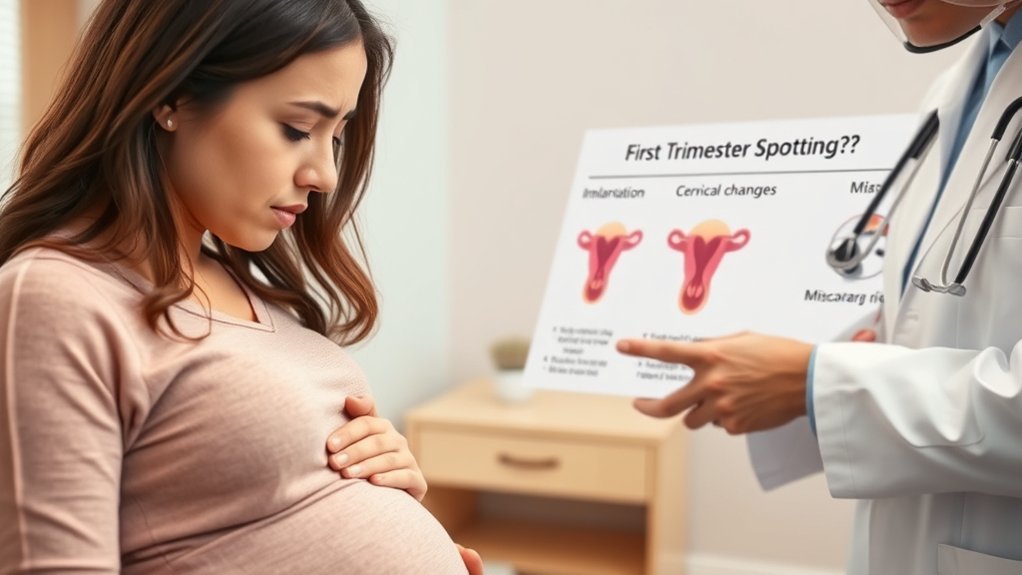Spotting in the first trimester can be concerning, but it’s not always a sign of trouble. Many women experience light brown or pink discharge due to hormonal changes or implantation bleeding. However, it’s essential to recognize when spotting may indicate complications, especially if accompanied by severe cramping or heavy bleeding. Understanding the nuances of these symptoms can help you determine the appropriate next steps and when to seek medical advice. What should you look for?
Understanding Spotting in Early Pregnancy

When you’re in the early stages of pregnancy, spotting can understandably cause concern. It’s vital to recognize that light spotting, often referred to as implantation bleeding, can occur as the fertilized egg attaches to the uterine lining. This typically happens around the time your period would have been due.
Spotting may also manifest as brown or pink discharge, which can be alarming but isn’t always indicative of a problem. It’s important to monitor the amount and duration of spotting.
If it’s accompanied by severe cramping, heavy bleeding, or tissue passage, you should seek medical advice immediately. Understanding these nuances can help alleviate anxiety and guarantee you’re attuned to your body’s signals during this critical period.
Common Causes of First Trimester Spotting

In the first trimester, spotting can occur for several reasons that are essential to understand.
You might experience implantation bleeding as the embryo attaches to the uterine lining, or hormonal changes that can affect your body.
Additionally, it’s vital to be aware of miscarriage risk factors that could contribute to unexpected bleeding during this early stage of pregnancy.
Implantation Bleeding
Could spotting during the first trimester be a sign of implantation bleeding? Yes, it can. Implantation bleeding occurs when a fertilized egg attaches itself to the uterine lining, typically around six to twelve days after conception. This process may cause light spotting, which is often pink or brown rather than bright red. You might notice this spotting a few days before your expected period, leading to some confusion. Unlike a menstrual flow, implantation bleeding is usually very light and lasts only a few hours to a couple of days. It’s important to differentiate it from other potential causes of spotting. If you’re uncertain about any bleeding, consult your healthcare provider for proper assessment and reassurance.
Hormonal Changes
Hormonal changes during the first trimester can greatly influence your body and may lead to spotting. As your body adjusts to the new hormonal environment, several factors can contribute to this phenomenon. Understanding these changes can help you feel more at ease.
- Increased progesterone: This hormone supports pregnancy but can also lead to changes in your cervical tissue, causing light spotting.
- Estrogen fluctuations: Variations in estrogen levels may affect blood vessels and cause them to break, resulting in spotting.
- Cervical sensitivity: Your cervix becomes more sensitive due to increased blood flow, making it prone to minor bleeding, especially after intercourse.
While spotting can be normal, always consult your healthcare provider if you’re concerned about any symptoms.
Miscarriage Risk Factors
Spotting during the first trimester can sometimes indicate underlying issues, including the risk of miscarriage. Understanding the common risk factors can help you stay informed and proactive about your health.
| Risk Factor | Description | Impact on Miscarriage Risk |
|---|---|---|
| Advanced Maternal Age | Women over 35 face higher risks | Increased risk |
| Previous Miscarriages | History can indicate future risks | Increased risk |
| Chronic Health Conditions | Conditions like diabetes or hypertension can affect pregnancy | Increased risk |
| Lifestyle Factors | Smoking, alcohol, and drug use can negatively impact fetal health | Increased risk |
Recognizing these factors can help you seek appropriate care and support during your pregnancy journey. Always consult your healthcare provider if you have concerns.
When Is Spotting Considered Normal?

While any bleeding during early pregnancy can be concerning, it’s important to understand that some spotting can be considered normal.
Bleeding during early pregnancy can be alarming, yet some spotting may be a normal occurrence.
Typically, you might experience spotting during the following situations:
- Implantation bleeding: This can occur when the fertilized egg attaches to the uterine lining, usually around the time your period is due.
- Hormonal changes: Fluctuations in hormones, especially early in pregnancy, can lead to light spotting.
- Cervical irritation: Increased blood flow to the cervix can cause minor bleeding after intercourse or a pelvic exam.
If you experience spotting, monitor the situation closely.
While some spotting can be normal, it’s essential to consult your healthcare provider for personalized advice and to rule out any potential complications.
Symptoms to Monitor Alongside Spotting
If you experience spotting during the first trimester, it’s essential to monitor any accompanying symptoms closely.
Pay attention to abdominal pain, especially if it’s severe or persistent, as this may indicate a problem. Cramping can also be common, but if it intensifies or is associated with heavy bleeding, it’s important to take note.
Additionally, look out for any signs of infection, such as fever, chills, or unusual discharge. Changes in breast tenderness or symptoms of nausea can also be relevant.
Tracking these symptoms allows you to provide accurate information to your healthcare provider. Remember, understanding your body’s signals can help guarantee you receive the appropriate care if necessary.
When to Contact Your Healthcare Provider
Recognizing when to contact your healthcare provider is essential for ensuring your well-being during the first trimester.
Contacting your healthcare provider is crucial for your well-being during the first trimester. Trust your instincts and seek guidance when needed.
While some spotting can be normal, certain signs warrant immediate attention. You should reach out if you experience:
- Heavy bleeding, soaking through one or more pads in an hour
- Severe abdominal pain or cramping, especially if accompanied by bleeding
- Any signs of dizziness, fainting, or rapid heartbeat
These symptoms could indicate complications that require prompt evaluation.
Always trust your instincts; if something feels off, don’t hesitate to consult your healthcare provider. They can provide the necessary guidance and reassurance, ensuring both your health and the health of your pregnancy are prioritized.
Differences Between Spotting and Menstrual Bleeding
Understanding the differences between spotting and menstrual bleeding is essential for your health during the first trimester.
You’ll notice distinctions in color, consistency, timing, and accompanying symptoms that can help you identify what you’re experiencing.
Recognizing these variations can aid in making informed decisions regarding your care.
Color and Consistency Differences
While both spotting and menstrual bleeding can involve blood, their color and consistency often differ markedly. Understanding these differences can help you identify what you’re experiencing.
- Color: Spotting is typically lighter, often pink or brown, whereas menstrual bleeding tends to be bright red.
- Consistency: Spotting usually appears as a light discharge, while menstrual bleeding has a thicker, more substantial consistency.
- Volume: Spotting is minimal and may only require a panty liner, whereas menstrual bleeding usually necessitates the use of pads or tampons.
These distinctions can provide valuable insights into your reproductive health. If you’re uncertain about what you’re experiencing, consulting a healthcare professional is always a wise choice.
Timing and Frequency Factors
Timing and frequency are essential factors that help differentiate spotting from menstrual bleeding. Spotting typically occurs between menstrual periods and may last for a few hours to a couple of days.
In contrast, menstrual bleeding usually follows a consistent cycle, lasting three to seven days with a more substantial flow. If you notice light bleeding shortly after conception, it might indicate implantation bleeding, which occurs around six to twelve days after fertilization.
Menstrual bleeding, however, is generally predictable and follows a regular schedule. If you’re experiencing irregular or unusual bleeding patterns, it’s vital to consult a healthcare professional for further evaluation.
Understanding these timing and frequency differences can aid in identifying what you may be experiencing during your first trimester.
Accompanying Symptoms Comparison
When you experience bleeding during the first trimester, it’s crucial to recognize the accompanying symptoms that can help distinguish between spotting and menstrual bleeding. Spotting typically presents with lighter flow and fewer associated symptoms, while menstrual bleeding often includes more pronounced indicators.
Consider these distinguishing factors:
- Color: Spotting may appear as light pink or brown, whereas menstrual blood is usually bright red.
- Flow: Spotting is generally lighter and may not require a pad or tampon, while menstrual bleeding often necessitates menstrual products.
- Cramping: Spotting usually involves mild cramps, whereas menstrual bleeding can cause more severe cramping and discomfort.
Understanding these differences can help you assess your situation and determine when to seek medical advice.
Emotional Impact of Spotting During Pregnancy
Experiencing spotting in the first trimester can evoke a complex array of emotions, as the uncertainty surrounding the situation often leads to heightened anxiety and fear.
You might feel overwhelmed by worries about your pregnancy’s viability, questioning whether this symptom indicates a serious issue. It’s common to oscillate between hope and despair, especially if you’re already dealing with personal or familial histories of pregnancy complications.
Feelings of guilt or helplessness may also arise, as you wonder if you’ve done something to cause the spotting.
It’s important to communicate your feelings with healthcare providers or support networks, as they can offer reassurance and guidance, helping you navigate this emotionally challenging experience and fostering a sense of control during a vulnerable time.
Frequently Asked Questions
Can Spotting Indicate an Impending Miscarriage?
Spotting can indicate an impending miscarriage, but it doesn’t always mean one is occurring. It’s essential to monitor other symptoms and consult your healthcare provider for personalized advice and accurate diagnosis.
How Long Can Spotting Last in Early Pregnancy?
Spotting in early pregnancy can last from a few hours to several days. It varies for each individual, and while it may be normal, you should always consult your healthcare provider for personalized advice and reassurance.
Are There Any Home Remedies for Spotting?
While home remedies like hydration, rest, and a healthy diet may support your overall wellbeing, it’s essential to consult a healthcare professional for appropriate guidance when experiencing spotting, as underlying issues may need attention.
Does the Color of Spotting Matter in Pregnancy?
About 20% of pregnant women experience spotting. The color of spotting can indicate different issues; bright red might suggest fresh blood, while brown often signifies older blood. Always consult your healthcare provider for assessment and guidance.
Can Stress Cause Spotting in the First Trimester?
Yes, stress can cause spotting in the first trimester. Elevated stress levels may impact your body, leading to hormonal changes that sometimes result in light bleeding. It’s crucial to discuss any spotting with your healthcare provider.
Conclusion
In conclusion, spotting during the first trimester can often be a normal part of early pregnancy, but it’s crucial to remain vigilant. Just as a flickering candle can illuminate a dark room, understanding the signs and symptoms can guide you through uncertainties. If you experience severe cramping or heavy bleeding, don’t hesitate to contact your healthcare provider. By staying informed, you can better navigate this delicate period and guarantee both your well-being and that of your developing baby.
